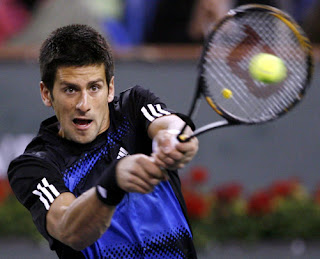Junior tennis
In tennis, a junior is a player 18 and under who is still legally protected by a parent or guardian. Players on the main adult tour who are under 18 must have documents signed by a parent or guardian. These players, however, are still eligible to play in junior tournaments.
The International Tennis Federation (ITF) conducts a junior tour that allows juniors to establish a world ranking and an Association of Tennis Professionals (ATP) or Women's Tennis Association (WTA) ranking. Most juniors who enter the international circuit do so by progressing through ITF, Satellite, Future, and Challenger tournaments before entering the main circuit. The latter three circuits also have adults competing in them. Some juniors, however, such as Australian Lleyton Hewitt and Frenchman Gaël Monfils, have catapulted directly from the junior tour to the ATP tour by dominating the junior scene or by taking advantage of opportunities given to them to participate in professional tournaments.
In 2004, the ITF implemented a new rankings scheme to encourage greater participation in doubles, by combining two rankings (singles and doubles) into one combined tally. Junior tournaments do not offer prize money except for the Grand Slam tournaments, which are the most prestigious junior events. Juniors may earn income from tennis by participating in the Future, Satellite, or Challenger tours. Tournaments are broken up into different tiers offering different amounts of ranking points, culminating with Grade A.
Leading juniors are allowed to participate for their nation in the Junior Fed Cup and Davis Cup competitions as well. To succeed in tennis often means having to begin playing at a young age. To facilitate and nurture a junior's growth in tennis, almost all tennis playing nations have developed a junior development system. Juniors develop their play through a range of tournaments on all surfaces, accommodating all different standards of play. Talented juniors may also receive sponsorships from governing bodies or private institutions.
Match play
A tennis match is intended to be continuous. Because stamina is a relevant factor, arbitrary delays are not permitted. In most cases, service is required to occur no more than 30 seconds after the end of the previous point. This is increased to 2 minutes when the players change ends (after every odd-numbered game), and a 2 minute break is permitted between sets. Other than this, breaks are permitted only when forced by events beyond the players' control, such as rain, damaged footwear, damaged racquet, or the need to retrieve an errant ball. Should a player be determined to be stalling repeatedly, the chair umpire may initially give a warning followed by subsequent penalties of "point", "game", and default of the match for the player who is consistently taking longer than the allowed time limit.
In the event of a rain delay, darkness or other external conditions halting play, the match is resumed at a later time, with the same score as at the time of the delay, and the players at the same end of the court when rain halted play, or at the same position (north or south) if play is resumed on a different court.
Balls wear out quickly in serious play and, therefore, in ATP and WTA tournaments, they are changed after every nine games with the first change occurring after only seven games, because the first set of balls is also used for the pre-match warm-up.As a courtesy to the receiver, the server will often signal to the receiver before the first serve of the game in which new balls are used as a reminder that they are using new balls. However, in ITF tournaments like Fed Cup, the balls are changed in a 9-11 style. Continuity of the balls' condition is considered part of the game, so if a re-warm-up is required after an extended break in play (usually due to rain), then the re-warm-up is done using a separate set of balls, and use of the match balls is resumed only when play resumes.
A recent proposed rules change is to allow coaching on court during a match on a limited basis. This has been instituted in women's tennis for WTA Tour events from 2009 onwards.









